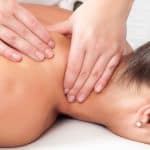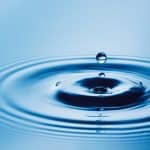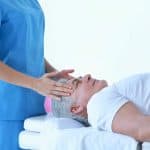For a majority of clients, a favorite part of bodywork is the back massage. There is something so nurturing, relaxing and healing about lying prone and having these large, stressed muscles of your body worked upon. Massage therapists with exposure to Traditional Chinese Medicine (TCM) know that there is a detailed system of reasoning behind back massage’s influence on the entire body. Located on either side of the spinal column, TCM’s back shu points give bodyworkers an accessible diagnostic and therapeutic map.
What Are the Back Shus?
The back shu points are like portals to our organs and associated meridians. The word “shu” literally means “to transport,” indicating the back shu points’ ability to move energy to and from our inner organs. Located on either side of the spine, each back shu point is level with a respective spinous process or sacral foramen. Positioned on the inner branch of the urinary bladder (UB) channel, the back shus stretch from lateral to the tip of the 3rd thoracic vertebrae down to lateral to the 2nd posterior sacral foramen.
Memorized by TCM practitioners, the following summary correlates each of the back shus with the 12 main organs and their channels:
- Lung – UB 13 is located 1.5 thumb widths lateral to the lower border of spinous process of the 3rd thoracic vertebrae.
- Pericardium – UB 14 is located 1.5 thumb widths lateral to the lower border of the spinous process of the 4th thoracic vertebrae.
- Heart – UB 15 is located 1.5 thumb widths lateral to the lower border of the spinous process of the 5th thoracic vertebrae.
- Liver – UB 18 is located is located 1.5 thumb widths lateral to the lower border of the spinous process of the 9th thoracic vertebrae.
- Gallbladder – UB 19 is located 1.5 thumb widths lateral to the lower border of the spinous process of the 10th thoracic vertebrae.
- Spleen – UB 20 is located 1.5 thumb widths lateral to the lower border of the spinous process of the 11th thoracic vertebrae.
- Stomach – UB 21 is located 1.5 thumb widths lateral to the lower border of the spinous process of the 12th thoracic vertebrae.
- Triple Burner – UB 22 is located 1.5 thumb widths lateral to the lower border of the spinous process of the 1st lumbar vertebrae.
- Kidneys – UB 23 is located 1.5 thumb widths lateral to the lower border of the spinous process of the 2nd lumbar vertebrae.
- Large Intestine – UB 25 is located 1.5 thumb widths lateral to the lower border of the spinous process of the 4th lumbar vertebrae.
- Small Intestine – UB 27 is located 1.5 thumb widths lateral to the 1st posterior sacral foramen.
- Urinary Bladder – UB 28 is located 1.5 thumb widths lateral to the 2nd posterior sacral foramen.
Diagnostic Use
Simple observation or palpation of a back shu can reveal an imbalance in the corresponding organ system. When an organ is impaired, or the respective meridian is blocked or deficient, it is common for the back shu point to be tender. Also indicative of an imbalance in the corresponding organ or meridan, a pimple or other skin reaction may be apparent on a back shu point. For this reason, these points can give observant practitioners a great deal of diagnostic information.
Therapeutic Use
Upon studying the patterns of organ imbalance and their associations, the back shus can be chosen as a therapeutic tool. For example, a client with an imbalance in his or her digestive energy can extract great benefit from stimulation of the spleen and stomach back shus. These points are known to be adaptive, meaning they will tonify or sedate depending on the function needed. Thus, a practitioner can offer a therapeutic massage by simply stimulating the back shu associated with a client’s condition – without the need for extensive TCM diagnostics.
A client without any specific complaints or reactive shu points will always benefit from stimulation of all back shus. Commonly practiced in TCM pediatric massage, working all of the shu points encourages healthful and balancing energy flow throughout the entire internal organ system.
Once familiar with where each back shu is located and what organ that point corresponds with, massage therapists can be more deliberate in their application of techniques. Stimulating the areas covered by this special category of points and observing any anomalies at their locations brings another dimension of healing to the assessment and treatment of the learned massage practitioner.















